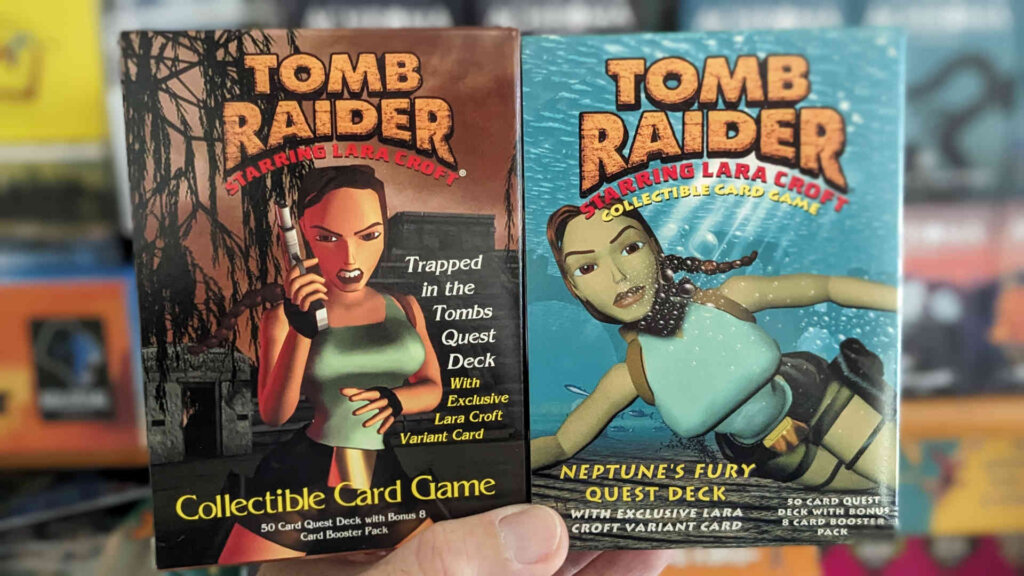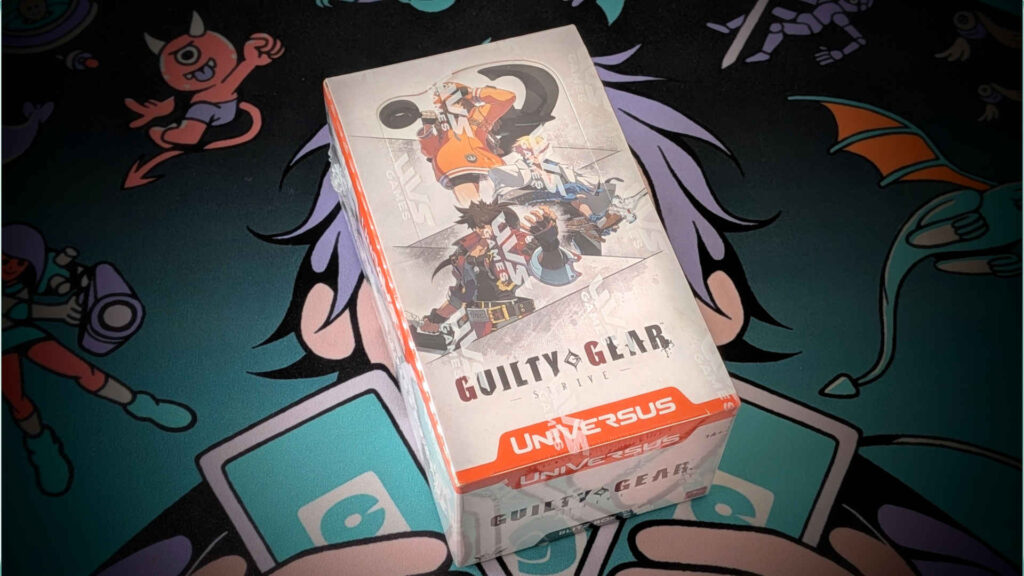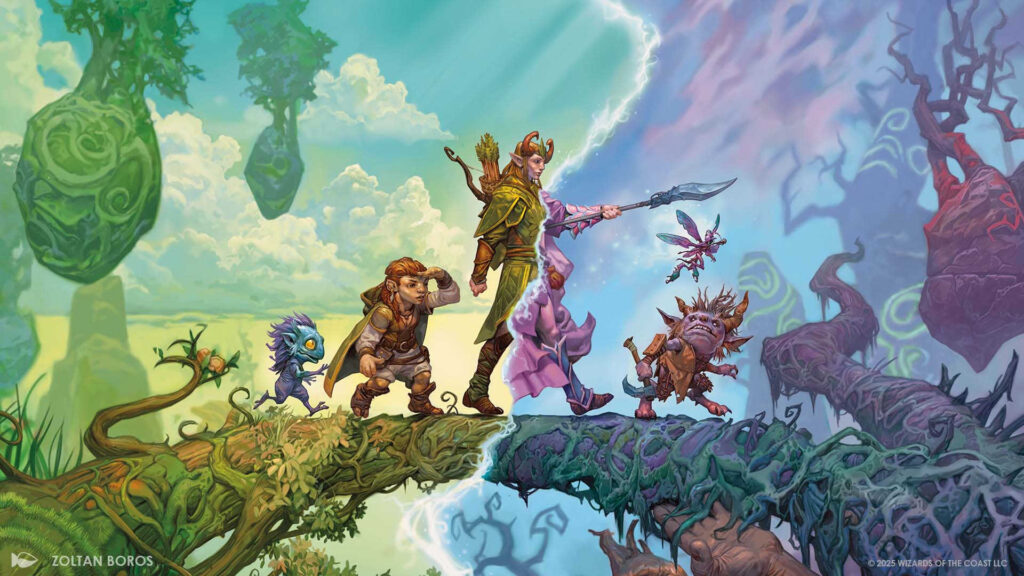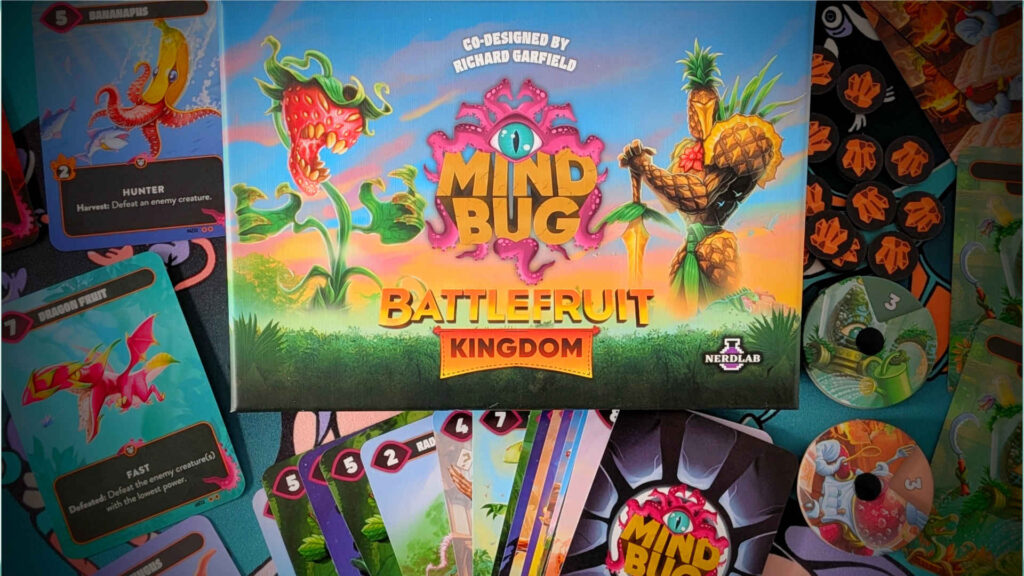Even if you weren’t a gamer in the 90s, it was impossible to avoid Lara Croft – the protagonist of video game series, Tomb Raider.
Despite the close association with Sony and their PlayStation brand, the first Tomb Raider game to emerge (developed by Core Design and published by Eidos) was on the Sega Saturn in 1996, following on PlayStation and PC shortly afterwards.
Lara Croft, the armed and very acrobatic archaeologist, emerged as Girl Power took centre stage in pop culture (thanks, Spice Girls!) and became a near-immediate icon, praised as being one of the first strong, female video game protagonists – even though she was fashionably late to that particular party.
That honour, if we’re including non-human characters, goes to Ms. Pac Man – but if we are specifying humans, it’s Toby ‘Kissy’ Masuyo in Namco’s forgotten arcade game, Baraduke, who takes that particular prize.
In any case, you couldn’t even go to a U2 concert without spotting Tomb Raider’s acrobatic polygonal protagonist – she appeared on screen during performances on the band’s PopMart tour in 1997.
Their association with Lara Croft didn’t end there either – she also appeared in the music video for U2 song Elevation in 2001, which also tied into (and featured clips from) the Angelina Jolie movie Lara Croft: Tomb Raider.
So naturally, given that CCGs – collectable card games – were born in the 90s (and, much like Lara Croft and Tomb Raider itself, almost immediately exploding in popularity) it’s perhaps no surprise that she starred in one of her own.
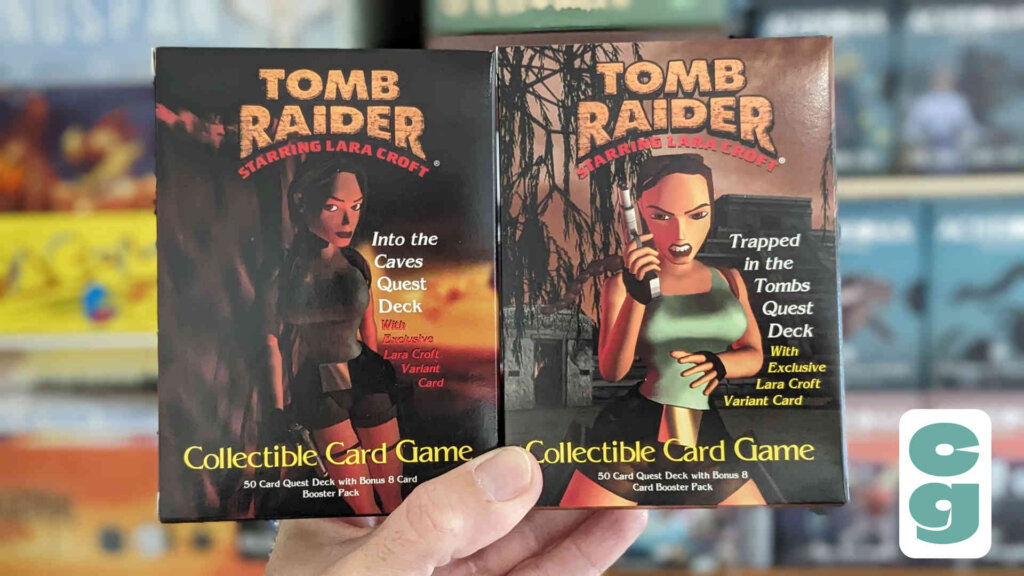
With Lara Croft and Tomb Raider themed cards set to arrive in Magic: The Gathering via a Secret Lair drop – you can check out our MTG Tomb Raider card list for more details – I thought it was the perfect time to take a look at the original Tomb Raider Collectable Card Game (note that ‘Collectible’ is the spelling used on the box, however!).
Designed by David Hewitt – billed as the sole creator of the game, Hewitt was also co-designer on several other CCGs.
Notably, a few of Hewitt’s credits are for collectable card games featuring other licensed properties – such as Babylon 5 and Aliens vs Predator – though Tomb Raider, released in 1999, seems to have been his first solo game design.
Sadly, unlike the immediate and lasting impact of the video game series, the CCG seems all but forgotten these days – having not made much of a splash at all upon release and only just making it to three set releases (though the third, Big Guns, didn’t even release in all territories).
So let’s take a look at the Tomb Raider CCG, which has largely been lost in the mists of time – is it a treasure that deserves to be excavated and preserved? Or is it now a worthless relic?
First things first – there’s no escaping the very 90s aesthetics of Tomb Raider, which largely uses the 3D characters and settings from the first three video games for the basis of its card and box art.
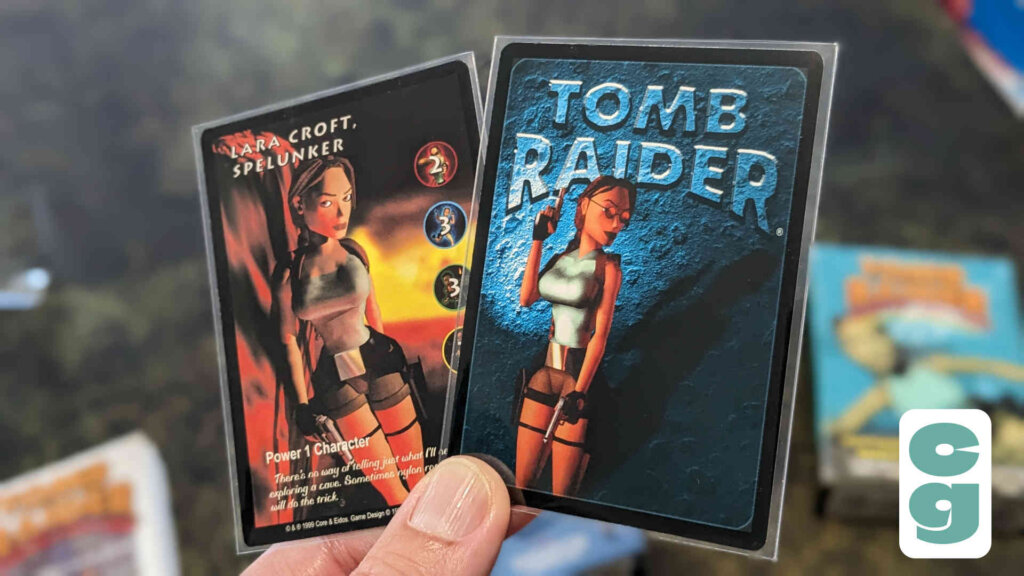
There was a time when the game began to quickly look dated – which wasn’t far off back in 1999 – so that likely didn’t help the game’s long term chances, but honestly there’s a real charm and nostalgic quality to those low-poly, early Saturn/PlayStation era visuals now.
Many cards do also use pre-rendered images that were deployed for box art and other marketing materials in the 90s and early 00s; these have aged ever so slightly more gracefully than the in-game screenshots, but also retain a real sense of nostalgia, particularly for those of us who’ve been gamers for decades!
Video game card art aside, the Tomb Raider CCG has a relatively uncluttered and easy to absorb look for its card text and general design; that is, aside from the slightly awkward cursive script at the bottom of most cards, representing Lara’s own quotes, thoughts and recollections from her journal.
So that’s our first impressions out of the way – how does the game play?
The Tomb Raider CCG actually feels more like a board game than a collectable card game, in which two or more players compete, as Lara Croft or rival Tomb Raiders, to find the treasure on a ‘map’ of cards.
Interestingly – and unlike almost all CCGs either at the time or even now – the Tomb Raider CCG has fully playable solitaire rules included with its starter decks (known as ‘Quest Decks’ in the particular parlance of the game).
This means that, if you’re not fussed about competing with other people, you can pit your wits against the game itself and raid tombs alone – just as Lara Croft does (for the most part!) in many of the best tomb raider video games.
If, however, you do want to play as other characters, you’ll need to find them in booster packs – or, perhaps an easier way to get hold of them these days, via online marketplaces such as eBay.
During the game, you’ll explore the level – built with location cards from your collection – overcoming obstacles, fighting creatures (or even other Tomb Raiders, if you’re not playing alone) and ultimately uncovering the main treasure room and (hopefully) finding the main treasure in order to win.
Along the way, you’ll also be trying your best to avoid traps and discover useful bits and pieces of equipment too.
Exploring the level’s map is really straightforward – you turn over a location card and move your Lara Croft pawn according to what your character’s movement score (on their card) is.
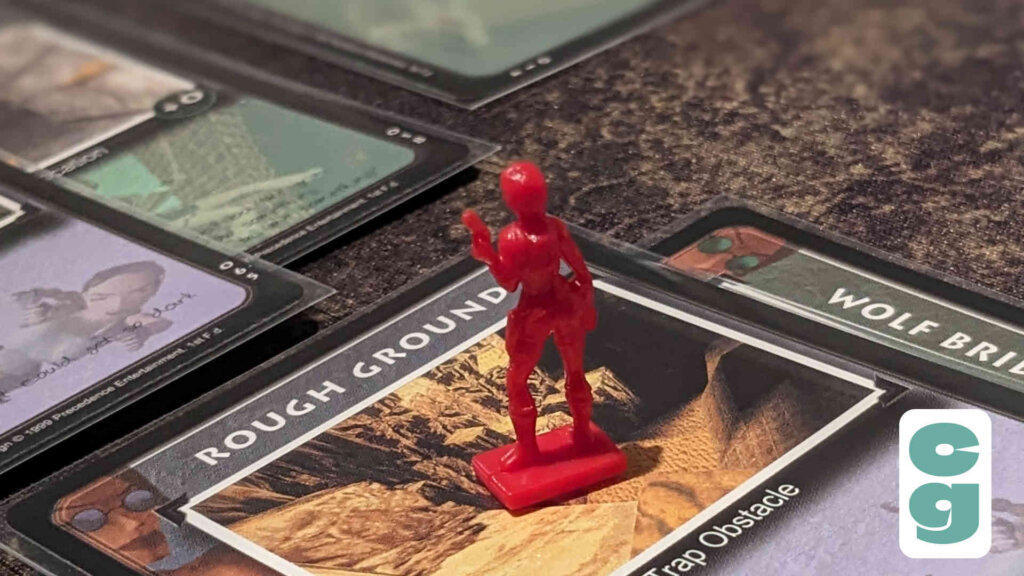
If you encounter enemies or traps (which can be added by your opponents, or from a deck of obstacles you’ll construct yourself if you’re going on a solo tomb raid), you roll the dice to try and beat their difficulty rating – if you do, you can then search the location (another die roll!) for equipment.
Perhaps oddly, the equipment you find is already in your hand, so you won’t be subject to the luck of the draw entirely – whatever you discover can come from your hand without it being a completely blind draw from a deck.
One of the best things about the Tomb Raider CCG is just how playable and enjoyable the game is straight out of the box.
This could partially explain the unfortunately premature demise of the game – though the game’s publisher, Precedence, whose board and card game output mostly consisted of licensed games, folding in 2002 (after numerous products seemed to be overprinted and underperformed, Tomb Raider included) obviously played a big part in that too.
Regardless of the publisher’s difficulties, it’s important to note that, for all games based around collecting new elements to continue playing or constructing with, if players aren’t sufficiently motivated to buy more and more boosters, the financial model just won’t work to ensure the game’s survival.
The Tomb Raider CCG’s boosters also had a reputation for awful card distribution too; there’s a sense that many games suffered from this, back in the early days of CCGs – with companies not really understanding how to create effective and compelling booster pack contents, that would keep players eager to crack open new packs and keep coming back for more.
In fact, even now, the first – and still the biggest – CCG in the world, Magic: The Gathering, has just recently rethought how its boosters work in order to solve problems (mostly of its own making) relating to players becoming overwhelmed or confused with the different booster pack types.
You can check out more details on this in our new MTG booster pack type article.
It’s not the first time that Magic: The Gathering has done this, either – with countless changes to booster pack types over the years, it’s clear that even the industry’s leading card game can still struggle with this despite its popularity and the resources at the disposal of publishers Wizards of the Coast.
Though Tomb Raider didn’t have that particular problem with different types of booster packs, it did have unappealing ones – the boosters for the first two sets featured just 8 cards in each pack, with 5 of them being common, 2 uncommon and a single rare.
As previously mentioned, three sets were released; a further expansion set – named Uncovered – was due to launch in the Summer of 2000, but never made it into production.
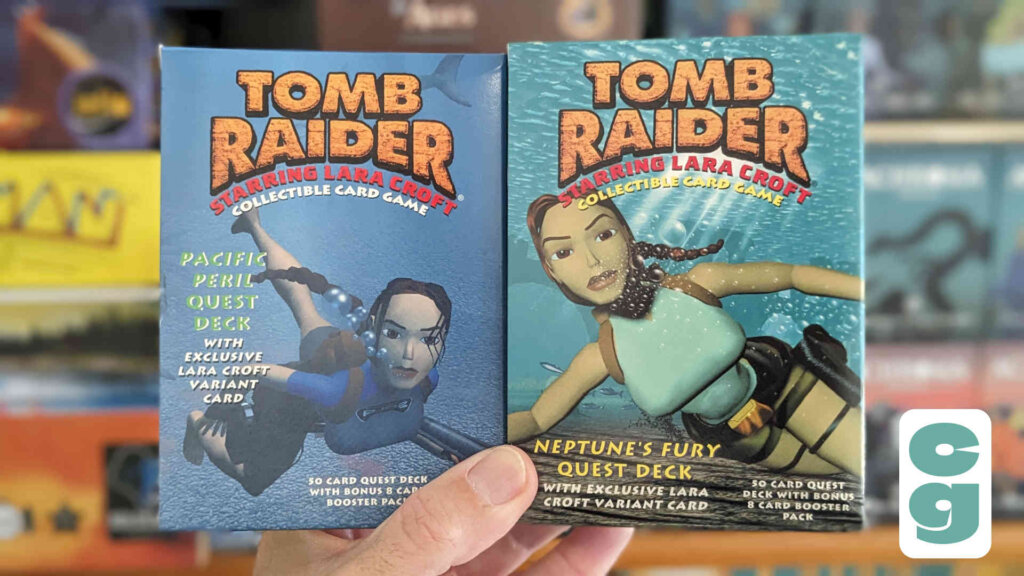
The original Premier set had two Quest Decks: Into the Caves and Trapped in The Tombs, as did the second expansion – with the awful title Slippery When Wet, playing on the awkward, laughably juvenile attempts to constantly make low-poly Lara a ‘sex symbol’ – Pacific Peril and Neptune’s Fury.
The third set, Big Guns, didn’t have Quest Decks – but did add one extra card to each booster, taking the total to 9 cards per pack. Sadly, these were rare and difficult to acquire for most fans back in the day – and tend to fetch a pretty penny right now!
In any case, adding more powerful – or just different – characters, along with tougher or more varied traps, equipment and treasure is of course possible with cards found in boosters.
In fact, each Quest Deck does have an 8 card booster pack included, so if you manage to get hold of a sealed deck, you’ll also have the possibility of at least a little bit of customisation of the starter’s cards.
Also included with a Quest Deck are two dice, a plastic Lara Croft pawn (each type of Quest Deck’s pawn is a different colour), two dice (just like the pawn in each different deck, the dice colour also depends on which type of deck you have), a depth tracker and a sheet of cardboard tokens to be punched out.
If you’re a contemporary player or collector of card games, you’ll notice that the production values and quality of the cards/components here aren’t the best.
They’re functional and perfectly playable, but we’ve been spoiled, certainly in more recent years, with big budget games – licensed and otherwise, with examples such as Disney Lorcana proving the point admirably – that feature both incredible, eye-catching art, beautifully presented card layouts and stunning foil card treatments too.
In that respect, the Tomb Raider CCG certainly does feel – somewhat aptly – like a bit of a relic of its time.
Yet its gameplay – which really does feel like a board game, rather than a CCG, and a reasonably well designed one too – despite a few dated elements, remains pretty compelling.
It won’t be winning any beauty contests, but David Hewitt’s design is far from a slapped-on, lazily utilised licence.
The inclusion of solo rules sets it apart even further as a game worth checking out; plus, if you do manage to get hold of the second set’s Quest Decks (Pacific Peril and Neptune’s Fury), you can even add in extra elements such as underwater locations and even the possibility of drowning!
It’s a brilliantly thematic game and, though numerous Tomb Raider board games have followed since the CCG’s unfortunately early demise, the Tomb Raider CCG is arguably still the most successful at capturing the feel of the classic video games.
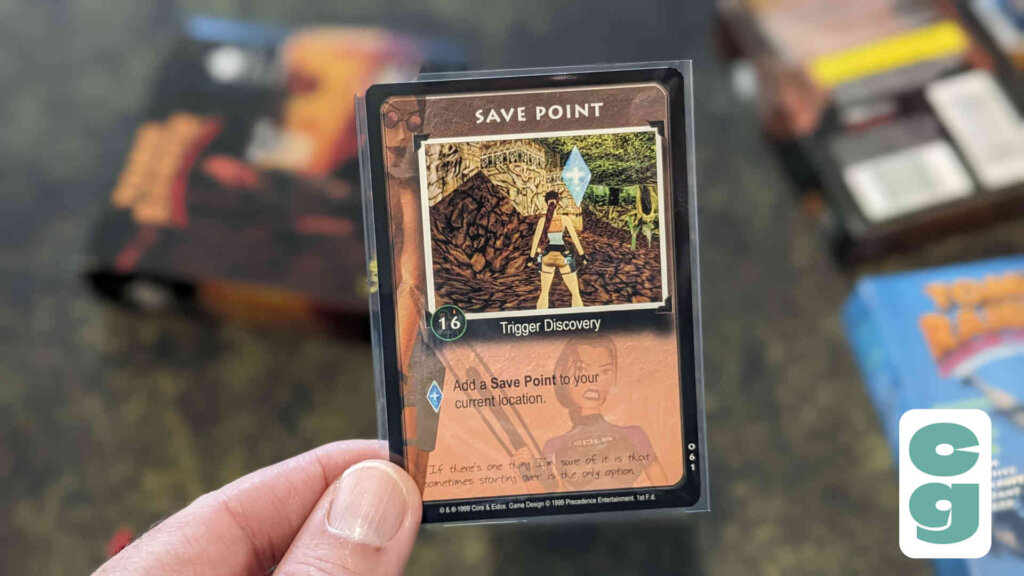
You even ‘save’ your game and create checkpoints where you respawn in a level if you die, just like in the video games – there are numerous neat touches that bring the digital realm to the tabletop.
There’s a few awkward issues that can arise if location cards can’t be placed – new cards can only be added to the level layout if they line up with exit arrows on cards already played – and some of the rarer cards are incredibly powerful, but near impossible to find these days.
Along with this, the cardboard tokens also have a very dated feel to them; they’re functional and clear, but you do expect more thematic design elements – yes, even with tokens/markers – in games these days.
Additionally, the depth tracker is a very thin strip of glossy paper. Even next to the flimsy, plain cardboard counters this feels like a corner that’s been cut; there surely could have been a better way to keep track of depth – especially as it doesn’t easily lay flat during play.
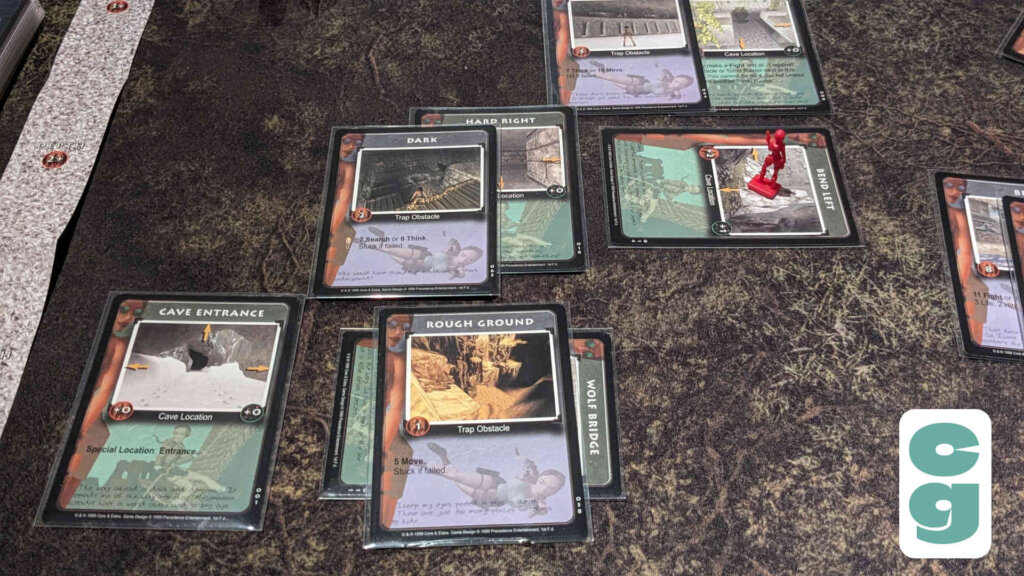
The character stats could definitely have used a bit of a more obvious indicator as to which stat is which; failing that, the skill test indicator on each card should really have been colour coded to match the colours of each stat on the character cards.
It’s worth noting also that the rulebook is dauntingly thick and feels incredibly overwhelming at first; the rules are definitely not explained with any intention of being concise!
However, the first section is taken up with a Tutorial game that eases you in slightly, with the more in-depth rules following that.
Finally, solitaire rules and then suggested level set-ups, followed by variant level goals and even rules for making a campaign, as well as designing your own levels, are all present – which demonstrate just how flexible and fully formed the Tomb Raider CCG is straight from a single Quest Deck.
Given the Tomb Raider CCG’s short lifespan, it’s possible that the issues with production quality (which also, unfortunately, extends to the cards themselves – which are thin and sometimes poorly cut) could have been addressed somewhat in later sets – these are somewhat forgivable flaws that don’t tarnish the overall experience too much.
It’s really not difficult or expensive to find Quest Decks even now; due to publishers Precedence massively overprinting the game (and, consequently, being left with plenty of unsold inventory – adding another reason for the game’s untimely end), it’s still common to find sealed Quest Decks of all types too.
Though the Premier set are the ones you’ll most commonly come across (and, subsequently, cheaper to acquire), the Slippery When Wet Quest Decks still pop up fairly frequently for sale.
So why not take the plunge and check out the Tomb Raider: Collectible Card Game for yourself?
If you’re a fan of the game series, it’s definitely worth the time and effort to track it down – despite being cheap to acquire, the Tomb Raider Collectable Card Game is far from a worthless relic.


